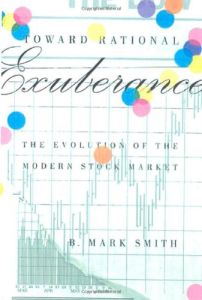Melden Sie sich bei getAbstract an, um die Zusammenfassung zu erhalten.

Melden Sie sich bei getAbstract an, um die Zusammenfassung zu erhalten.
B. Mark Smith
Toward Rational Exuberance
The Evolution of the Modern Stock Market
FSG, 2001
Was ist drin?
The U.S. stock market has steadily grown since its inception, with just a few minor interruptions along the way, like depression, panic and war.
Recommendation
Since it now appears that the laws of economics do indeed still apply to the U.S. stock market, it seems a good time to brush up on the history of Wall Street. Such a look back is especially important to the millions of investment bankers, brokers and individual investors who cut their teeth in the "irrational exuberance" of the ’90s and are now catching their first real glimpse of the bear. B. Mark Smith’s comprehensive history of the U.S. equity market demonstrates, if nothing else, that this ain’t the first time a bubble’s burst and it sure won’t be the last. The beauty of Smith’s book derives from his ability to link the development of the market with the history of the times. He begins with the founding of the first exchange in the late 1700s and traces the market’s increasingly powerful role through the last century, when it helped fuel modern technological and economic growth. The book is especially intriguing when it discusses the relatively unknown early years of the market, before its big crash in 1929. getAbstract recommends this fascinating history to executives, financiers and academics, as well as to a broad audience of history buffs, even those with little knowledge about stocks.
Summary
About the Author
B. Mark Smith was a professional stock trader for nearly two decades, first with CS/First Boston Corporation, where he became director, then as vice president of Goldman, Sachs & Company. He has since retired from the stock market.


















Comment on this summary